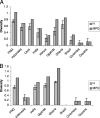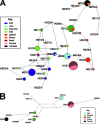Discordant patterns of genetic variation at two chloroquine resistance loci in worldwide populations of the malaria parasite Plasmodium falciparum
- PMID: 18411325
- PMCID: PMC2415780
- DOI: 10.1128/AAC.00089-08
Discordant patterns of genetic variation at two chloroquine resistance loci in worldwide populations of the malaria parasite Plasmodium falciparum
Abstract
Mutations in the chloroquine resistance (CQR) transporter gene of Plasmodium falciparum (Pfcrt; chromosome 7) play a key role in CQR, while mutations in the multidrug resistance gene (Pfmdr1; chromosome 5) play a significant role in the parasite's resistance to a variety of antimalarials and also modulate CQR. To compare patterns of genetic variation at Pfcrt and Pfmdr1 loci, we investigated 460 blood samples from P. falciparum-infected patients from four Asian, three African, and three South American countries, analyzing microsatellite (MS) loci flanking Pfcrt (five loci [approximately 40 kb]) and Pfmdr1 (either two loci [approximately 5 kb] or four loci [approximately 10 kb]). CQR Pfmdr1 allele-associated MS haplotypes showed considerably higher genetic diversity and higher levels of subdivision than CQR Pfcrt allele-associated MS haplotypes in both Asian and African parasite populations. However, both Pfcrt and Pfmdr1 MS haplotypes showed similar levels of low diversity in South American parasite populations. Median-joining network analyses showed that the Pfcrt MS haplotypes correlated well with geography and CQR Pfcrt alleles, whereas there was no distinct Pfmdr1 MS haplotype that correlated with geography and/or CQR Pfmdr1 alleles. Furthermore, multiple independent origins of CQR Pfmdr1 alleles in Asia and Africa were inferred. These results suggest that variation at Pfcrt and Pfmdr1 loci in both Asian and African parasite populations is generated and/or maintained via substantially different mechanisms. Since Pfmdr1 mutations may be associated with resistance to artemisinin combination therapies that are replacing CQ, particularly in Africa, it is important to determine if, and how, the genetic characteristics of this locus change over time.
Figures



Similar articles
-
Geographic patterns of Plasmodium falciparum drug resistance distinguished by differential responses to amodiaquine and chloroquine.Proc Natl Acad Sci U S A. 2009 Nov 10;106(45):18883-9. doi: 10.1073/pnas.0911317106. Epub 2009 Nov 2. Proc Natl Acad Sci U S A. 2009. PMID: 19884511 Free PMC article.
-
High prevalence of pfcrt-CVIET haplotype in isolates from asymptomatic and symptomatic patients in south-central Oromia, Ethiopia.Malar J. 2014 Mar 27;13:120. doi: 10.1186/1475-2875-13-120. Malar J. 2014. PMID: 24674605 Free PMC article.
-
Population genetic analyses of Plasmodium falciparum chloroquine receptor transporter gene haplotypes reveal the evolutionary history of chloroquine-resistant malaria in India.Int J Parasitol. 2011 Jun;41(7):705-9. doi: 10.1016/j.ijpara.2011.03.002. Epub 2011 Apr 9. Int J Parasitol. 2011. PMID: 21447338
-
Genetics of chloroquine-resistant malaria: a haplotypic view.Mem Inst Oswaldo Cruz. 2013 Dec;108(8):947-61. doi: 10.1590/0074-0276130274. Mem Inst Oswaldo Cruz. 2013. PMID: 24402147 Free PMC article. Review.
-
pfcrt is more than the Plasmodium falciparum chloroquine resistance gene: a functional and evolutionary perspective.Acta Trop. 2005 Jun;94(3):170-80. doi: 10.1016/j.actatropica.2005.04.004. Acta Trop. 2005. PMID: 15866507 Review.
Cited by
-
Geographic structuring of the Plasmodium falciparum sarco(endo)plasmic reticulum Ca2+ ATPase (PfSERCA) gene diversity.PLoS One. 2010 Feb 25;5(2):e9424. doi: 10.1371/journal.pone.0009424. PLoS One. 2010. PMID: 20195531 Free PMC article.
-
Surveillance of Antimalarial Resistance Pfcrt, Pfmdr1, and Pfkelch13 Polymorphisms in African Plasmodium falciparum imported to Shandong Province, China.Sci Rep. 2018 Aug 28;8(1):12951. doi: 10.1038/s41598-018-31207-w. Sci Rep. 2018. PMID: 30154519 Free PMC article.
-
Polymorphic patterns of pfcrt and pfmdr1 in Plasmodium falciparum isolates along the Thai-Myanmar border.Asian Pac J Trop Biomed. 2013 Dec;3(12):931-5. doi: 10.1016/S2221-1691(13)60181-1. Asian Pac J Trop Biomed. 2013. PMID: 24093782 Free PMC article.
-
Plasmodium falciparum Chloroquine-pfcrt Resistant Haplotypes in Brazilian Endemic Areas Four Decades after CQ Withdrawn.Pathogens. 2023 May 17;12(5):731. doi: 10.3390/pathogens12050731. Pathogens. 2023. PMID: 37242401 Free PMC article.
-
Large-scale survey for novel genotypes of Plasmodium falciparum chloroquine-resistance gene pfcrt.Malar J. 2012 Mar 28;11:92. doi: 10.1186/1475-2875-11-92. Malar J. 2012. PMID: 22453078 Free PMC article.
References
-
- Abdel-Muhsin, A. M., M. J. Mackinnon, E. Ali, K. A. el Nassir, S. Suleiman, S. Ahmed, D. Walliker, and H. A. Babiker. 2004. Evolution of drug-resistance genes in Plasmodium falciparum in an area of seasonal malaria transmission in Eastern Sudan. J. Infect. Dis. 189:1239-1244. - PubMed
-
- Alifrangis, M., M. B. Dalgaard, J. P. Lusingu, L. S. Vestergaard, T. Staalsoe, A. T. Jensen, A. Enevold, A. M. Ronn, I. F. Khalil, D. C. Warhurst, M. M. Lemnge, T. G. Theander, and I. C. Bygbjerg. 2006. Occurrence of the Southeast Asian/South American SVMNT haplotype of the chloroquine-resistance transporter gene in Plasmodium falciparum in Tanzania. J. Infect. Dis. 193:1738-1741. - PubMed
-
- Alifrangis, M., S. Enosse, R. Pearce, C. Drakeley, C. Roper, I. F. Khalil, W. M. Nkya, A. M. Ronn, T. G. Theander, and I. C. Bygbjerg. 2005. A simple, high-throughput method to detect Plasmodium falciparum single nucleotide polymorphisms in the dihydrofolate reductase, dihydropteroate synthase, and P. falciparum chloroquine resistance transporter genes using polymerase chain reaction- and enzyme-linked immunosorbent assay-based technology. Am. J. Trop. Med. Hyg. 72:155-162. - PubMed
-
- Alker, A. P., P. Lim, R. Sem, N. K. Shah, P. Yi, D. M. Bouth, R. Tsuyuoka, J. D. Maguire, T. Fandeur, F. Ariey, C. Wongsrichanalai, and S. R. Meshnick. 2007. Pfmdr1 and in vivo resistance to artesunate-mefloquine in falciparum malaria on the Cambodian-Thai border. Am. J. Trop. Med. Hyg. 76:641-647. - PubMed
-
- Anderson, T. J. 2004. Mapping drug resistance genes in Plasmodium falciparum by genome-wide association. Curr. Drug Targets Infect. Disord. 4:65-78. - PubMed
Publication types
MeSH terms
Substances
Grants and funding
LinkOut - more resources
Full Text Sources

